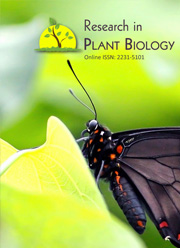Morphological and Biological Characterization of Monosporascus cannonballus isolates, responsible of watermelon decline in Kairouan's area
Keywords:
M. cannonballus, in vitro, culture media, temperature, pH, osmotic pressuresAbstract
Watermelon grown in Kairouan's region is infected by vine decline disease caused by M. cannonballus. In vitro tests showed that this pathogen produces perithecia with a diameter of 495 μm releasing ascospores with a diameter of 44 μm. The mycelium is very fine, rarely visible in the media KOMADA and TANAKA. The colony of different isolates on substrate culture such as Malt, MS and S, appears very dense. On PDA, the grayish brown color characteristic of this ascomycete was observed. The perithecia production in vitro test for this fungus requires relatively long period of incubation (45 days). The effect of culture media showed that the PDA, MS and Malt are the best for the mycelia development of M. cannonballus. The most favorable culture media for fructification arein descending order MS, S, PDA, Malt. M. cannonballus isolates tested in this study showed an optimum temperature of mycelial growth and reproduction of 30°C. MT15 andMT12 isolates originated from Chebika (Kairouan government) showed a significantmycelial growth at all temperatures of incubation. MT7 and MT14 isolates from the sameregion were the most fertile. The results of pH effect on M. cannonballus developmenthave revealed that the maximum mycelial growth occurred at pH 6 for most of isolates andfor the fructification occurred at pH 4 and pH 8. For the osmotic pression with the addition of NaCl and KCl, the optimal development for majority of isolates is registeredat -0.5 MPa and -2 MPa, with a minimum at -4MPa. The inhibition of the fructification of the M. cannonballus isolates occurred beyond -2MPa.Downloads
Download data is not yet available.
Published
15-08-2011
How to Cite
Salem I., B., N., B.-M., M., S., & M., C. (2011). Morphological and Biological Characterization of Monosporascus cannonballus isolates, responsible of watermelon decline in Kairouan’s area. Research in Plant Biology, 1(3). Retrieved from https://www.updatepublishing.com/journal/index.php/ripb/article/view/2580
Issue
Section
Articles



 .
. 